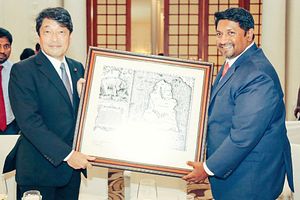The recent visit by Japanese Defense Minister Itsunori Onodera to India and Sri Lanka shows the increasing focus on these countries on the part of Tokyo as a part of its free and open Indo-Pacific (FOIP) strategy.
What is important about this visit was that it was the first visit by a Japanese defense minister to Sri Lanka. This assumes particular significance in the light of a Chinese-state owned company gaining a lease of 99 years to the Hambantota port in Sri Lanka, which straddles the key sea lanes of communication in the Indian Ocean region.
Onodera visited Hambantota port during this visit. In addition, Onodera, accompanied by the Sri Lankan Navy’s Eastern Area Naval Commander Rear Admiral Sumith Weerasinghe, also visited Trincomalee harbor, where he met with the crew of the Japanese Naval ship JS Ikazuchi. There are indications that Japan is planning to work with countries like India in Sri Lanka, given India’s close links and geographical proximity and also given the growing bonhomie between India and Japan. Tokyo also handed over two coast-guard patrol aircraft to Colombo, which are worth around $11 million.
China’s Belt and Road Initiative (BRI) has forced all countries, including Japan, to take notice in the Indo-Pacific. While Japan has expressed its interest in evaluating projects related to the Belt and Road Initiative (BRI) on a case-by-case basis, it is yet to join the initiative itself, while New Delhi has opted to mostly stay out of the Belt and Road Initiative (BRI) due to sovereignty concerns.
Before visiting Sri Lanka, the Onodera was in India, where he met his Indian counterpart, Nirmala Sitharaman. It has been reported that India and Japan are working on a logistics-sharing agreement, similar to the one India has signed with the United States, the Logistics Exchange Memorandum of Agreement. This will increase the interoperability between the Indian and Japanese navies. The two countries are already collaborating in a big way in the maritime realm with the JIMEX bilateral exercises and the trilateral Malabar exercises with the United States. Japan also maintains a base in Djibouti and hence the locations of India and Sri Lanka assumes a big significance for Japan’s Maritime Self-Defense Force.
The increasing use of the term Indo-Pacific dovetails with Japan’s own FOIP concept. It is worth noting here that India, Japan, Australia, and the United States had also resuscitated the “Quad” on the sidelines of the ASEAN and the East Asia Summits in Manila in November last year. Amid all this, Tokyo has also sent its helicopter carrier JS Kaga and its sister ships on a two-month deployment in the Indo-Pacific region where it will call at ports in India, Indonesia, Singapore, Sri Lanka, and the Philippines.
In 2007, Prime Minister Shinzo Abe, in his famous speech “Confluence of the Two Seas,” had mentioned that “the Pacific and the Indian Oceans are now bringing about a dynamic coupling as seas of freedom and of prosperity.” The Japanese defence minister’s recent swing through India and Sri Lanka only proves that Tokyo is now putting its money where its mouth is.
Dr Rupakjyoti Borah is with the Institute of South Asian Studies at the National University of Singapore (NUS). His recent book is The Elephant and the Samurai: Why Japan Can Trust India. He can be reached at [email protected] or on Twitter at @rupakj.

































